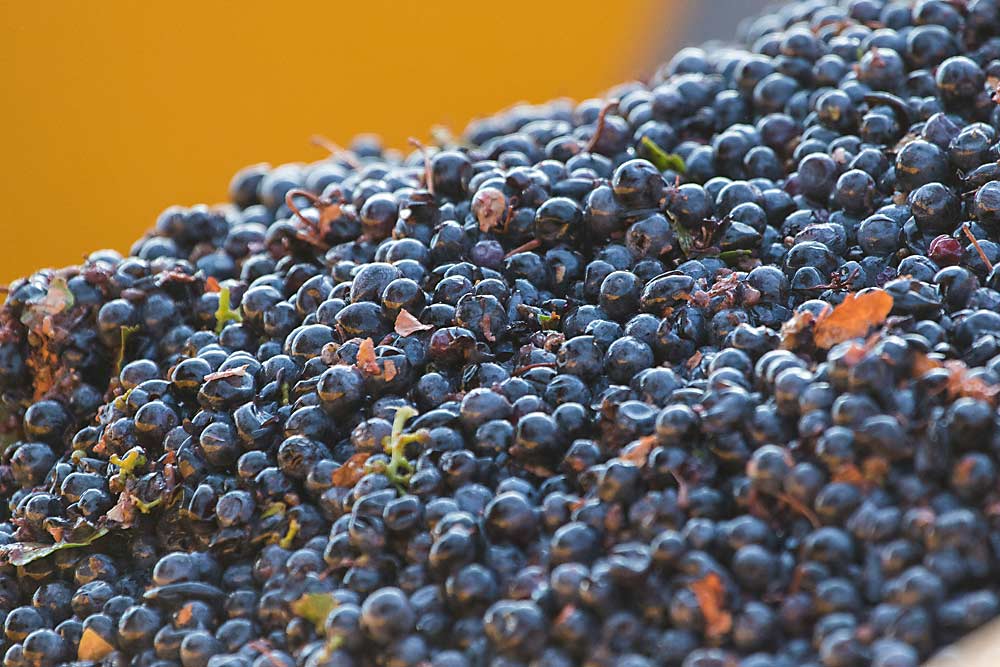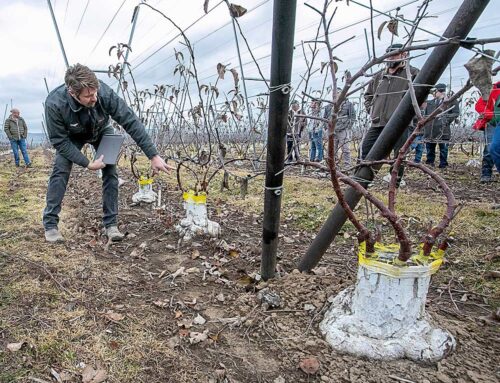
Cabernet Sauvignon grapes harvested in October 2015 at Cold Creek Vineyard near the Columbia River’s Hanford Reach area in Washington. Cold Creek is one of Ste. Michelle Wine Estate’s oldest and most prestigious vineyards in the state. (TJ Mullinax/Good Fruit Grower)
The future for the Washington wine industry remains bright, but some headwinds are coming in the near term that could dampen future prospects.
That’s the word from wine economist Chris Bitter of Vintage Economics at the Washington Winegrowers annual conference in Kennewick, Washington, in February.

Chris Bitter
“The key is to have realistic expectations, and you’re going to need to be very strategic in order to thrive in this type of environment,” Bitter said. “Rapidly evolving markets definitely create opportunities, but you have to be innovative and do your homework to figure out where those opportunities are.”
Wine consumption generally has slowed, which has resulted in excess supply on a global basis.
What has that meant for Washington?
According to the Washington State Liquor and Cannabis Board, packaged wine shipments grew 50 percent, or 4.2 million cases, from 2010 to 2016. Ste. Michelle Wine Estates accounted for 2.6 million cases.
Two key points can be drawn from those figures, Bitter said. One: Washington is heavily reliant on one company for that growth. Two: The state is heavily dependent on out-of-state demand. Out-of-state shipments represented 85 percent of that gain over the time period.
In 2017, total Washington shipments declined 5 percent, a sharp reversal from the annualized 7 percent increase of the previous six years.
The declines showed up in both out-of-state and in-state distribution, while direct-to-consumer sales at the winery were up (that includes both in-state and out-of-state retail sales at the winery).
Preliminary numbers for 2018 show shipments were up 3 percent — still 250,000 cases below the 2016 peak, so Washington has plateaued, he said. In addition, Washington is seeing bifurcation of its industry between its biggest player and the rest of the industry.
Ste. Michelle, which represents well over 60 percent of Washington wine shipments, was down 1 million cases from its peak in 2016, while the rest of the industry is up by 750,000 cases over the last two years, he said.
“A lot of the gain in 2018 was due to other wineries in the state,” he said. “The majority of the state’s top 100 wineries recorded solid volume gains.”
Nationally, competition from alternative alcoholic beverages, a focus on a healthier lifestyle, and the millennial generation drinking less wine, together are contributing to a plateau in wine sales, Bitter said. The $11-and-under segment of the market is contracting, which reflects why Ste. Michelle shipments are down, but premium and higher-priced segments of the market continue to do well.
The overall economic outlook for 2019 is for a modest slowdown — a moderating economy, not a recession, though experts say a recession is coming, he said. With a trade war, political gridlock in the U.S. and a slowing global economy, the risks are clearly to the downside.
“We have the second-longest economic expansion on record, and an unemployment rate somewhere near a 50-year low,” he said. “It’s hard to squeeze additional growth, so we’re going to see a recession at some point.”
For the wine industry, that means retail sales should continue to be the sweet spot, though there will be intensifying competition in every segment. “We have a strong dollar, excess global supply, which means more pressure from imports,” he said.
Washington had an explosion of satellite tasting rooms open in the last few years; as of 2018 year-end, there were 233 active additional location licenses in the state, with 40 issued in 2018 alone. More locations equal more competition for direct-to-consumer dollars.
In the grape market, growers have planted for strong demand, but now there’s an oversupply. Ste. Michelle, in particular, has cut back on some of its contracts; going forward, the outlook depends heavily on fortunes there.
“If they’re not expanding and taking on more grapes, the rest of the industry simply isn’t big enough to take up the slack,” he said. The company has the best value for the price and he expects to see their shipments turn around, “but these things take time,” Bitter said.
During a panel discussion, winemaker Wade Wolfe noted he’s seen at least three to four economic cycles such as this in his 30 years in business in Washington. In the late 1980s to early ’90s, growers replaced a lot of white varieties with red varieties. Then, in the late ’90s, there was an overabundance of Merlot.
“We adjusted to that. I’m very optimistic we will come through this as well. It’s a perennial cycle,” he said. “It inspires innovation to come out of it.”
When asked about the threats from competitive products, such as cannabis, and the fact that the millennial generation is drinking less wine, grower and winery owner Patrick Rawn said he doesn’t see wine and cannabis as interchangeable. And whether millennials will later evolve into wine consumers remains to be seen.
“They are not brand loyal. They also are not product loyal, and that creates risk. But it also creates opportunity for innovation and to deliver wine and the product where they choose to consume it in a different way,” Rawn said. •
—by Shannon Dininny
Related: Lessons in supply and demand for wine grape growers






Wade is right boom/ bust is the nature of many business cycles. Potatoes are a two or three year cycle, wine is seven to ten.
There is no such thing as a Millenial Cohort. Wine consumption has no correlation to birth date. There are many factors involved in wine consumption, disposable income, family culture, and education still rule.
Paul Vandenberg
Paradisos del Sol Winery and Organic Vineyard